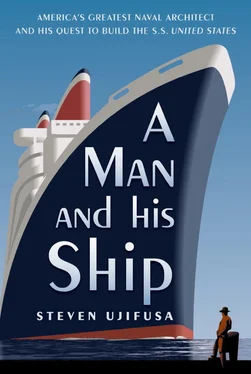Nearly sixty years earlier, Charles Dickens had endured a winter gale aboard Cunard’s first transatlantic liner, the wooden paddle wheeler Britannia. “Before it is possible to make any arrangement at all compatible with this novel state of things, the ship rights,” the wretchedly seasick novelist wrote. “Before one could say ‘Thank Heaven!’ she wrongs again…. All is grand, and all appalling and horrible in the last degree…. Only a dream can call it up again in all its fury, rage, and passion.” 11Despite decades of progress in ship design, Dickens’s description of life aboard a ship during a four-day gale could easily have been written of Mauretania ’s maiden voyage. A rogue wave broke a row of first-class cabin windows, drenching clothes and bed linens. In the first-class lounge, a large walnut display case ripped away from the bulkhead and crashed to the floor, hurling glass shards everywhere. 12For the seven hundred largely Irish immigrants in steerage, the experience was absolutely terrifying. Tightly packed into the forward part of the ship, they were subjected to the worst of the ship’s motion as Mauretania heaved and plunged in the storm. Mothers held screaming babies tightly in their arms, as spilled porridge and vomit sloshed across tables and onto the floor. But it was even worse for the “black gang” down in the gloom of the boiler rooms, where dozens of sooty stokers struggled to feed the furnaces. When Captain Pritchard saw steam pressure gauges dropping, an officer would squawk into the ship’s telephone, “More steam, more steam!” Chief Engineer John Currie strode up and down the boiler room alleys, yelling to his men as they heaved shovels of coal into the glowing fires. “Steady boys!” he bellowed. “Now keep her going and all work together.” 13
The second night out, with the storm going strong, passengers woke to a tremendous thud. Fearing the ship had hit something, they clambered up on deck to see that waves had torn loose the ten-ton spare anchor and sent it sliding across the forecastle deck. Pritchard slowed Mauretania and descended from the bridge in the driving rain and howling wind to face the problem. After an hour and a half of herculean effort, the crew resecured the anchor before it could gouge a hole in the deck. The soaked Pritchard returned to the bridge and Mauretania resumed her westward course. 14
“Show me the captain of a transatlantic liner, and I’ll show you a religious man,” William Francis Gibbs would say later. “Out there in dirty weather, you feel like nothing, and you have to believe.” 15He might have been one of the awestruck passengers who watched Mauretania’s crew struggle with the anchor that night; it is hard to imagine that the ship-obsessed twenty-one-year-old kept to his stateroom for much of the voyage at all. He would have known in advance all that had been written about Mauretania; this was his chance to investigate its workings firsthand. Exploring other designers’ ships, even if he had to be covert, was a habit he was to keep all his life.
On the fourth day, the storm subsided and the sun shone on the gently rolling waves of the Atlantic. Pritchard ordered a full head of steam, and Mauretania picked up speed, smoke trailing from her four funnels. That day, the ship made 624 miles at an average speed of 25.83 knots, a world record for a single day’s run.
On the fifth day, a dense fog rolled in. For safety, Pritchard slowed the liner to a crawl, and all hopes of breaking Lusitania ’s record vanished. When she arrived in New York on the wet, dreary afternoon of November 22, she had completed the run in 5 days, 5 hours, and 10 minutes, which was four hours more than Lusitania ’s maiden run. The average crossing speed was just 21.22 knots, only slightly faster than the old St. Louis, built a decade before. 16
To express their gratitude, the passengers collected nine hundred dollars for the stokers and engineers. Mauretania had not won the Blue Riband, but she had proved her potential as a seagoing thoroughbred. After the ship tied up at Pier 54 on the Hudson River, the head of Swan, Hunter shipyard boasted, “Not a bolt or screw about the engines was wrong. The vessel will continue to clip a little bit off the records each time she sails for some time to come.” 17
His prediction proved true. In 1909, after two years of swapping the record back and forth with her sister, Mauretania decisively captured the Blue Riband with a record eastbound crossing time of 4 days, 10 hours, and 51 minutes at an average speed of 26.06 knots. Mauretania would become the most famous and successful ship of its time, beloved by hundreds of thousands of travelers. For devotees of great ships, she was a model of elegance in form and function. “The Mauretania always fascinated me,” said Franklin Delano Roosevelt, then a young New York lawyer, “with her yacht-like lines—her four enormous black topped funnels—her appearance of power and good breeding.” 18
It was an appreciation of marine design that the young Gibbs shared with the future president—a lover of ships, who would later work with his fellow Harvard man to rebuild the American Navy.
On November 22, 1907, as Mauretania eased into her New York pier for the first time, a financial storm was brewing only a few blocks away. Wall Street was about to change forever William Francis Gibbs’s sense of place in the world. As the weary passengers disembarked at Pier 54, stevedores carefully unloaded $12.9 million of gold bullion from Mauretania ’s strong room. Bound for the vaults of the Treasury Department in Washington, the gold was evidence of an international financial panic. 19
The Panic of 1907 had begun earlier that year with industrial failures and a sharply falling stock market. By autumn, the prominent Knickerbocker Trust Company had failed, and one bank after another followed. The shock began to ripple beyond the financial markets. Angry swarms of depositors lined up outside of banks hoping to retrieve their savings before tellers ran out of cash. For William Francis Gibbs’s father, a big risk taker, the panic was a fatal blow.
Exactly what happened to all William Warren Gibbs’s supposed millions following the American Alkali scandal and the panic is unclear. Appearances were kept up, though the family was in debt simply from living expenses. In September 1908 Gibbs reenrolled at Harvard and moved back into Claverly Hall. He switched his concentration from engineering to economics, and excelled. Indeed, he was doing so well that he was excused from some of his final exams. 20At the end of his third year of studies, the economics department recommended that William Francis Gibbs receive a bachelor of science degree in economics, magna cum laude—on condition that he completed his pesky language requirement. It seemed that he had finally found himself academically.
But the spring of 1910 spelled the end of his time at Harvard. On April 8, one of the giant iron gates at the entry of the Gibbs mansion tore away from rusted hinges, fell toward the street, and crushed an eight-year-old newsboy to death. A photograph appeared in the papers the next day showing an elaborately scrolled gate resting on its side against one of the stone entrance portals. A young boy, probably a fellow “newsie,” stands next to the gate, a sour expression on his face. 21Shortly after the accident, the Gibbs family moved out of their Walnut Street mansion, decamping to a small rented house in the Main Line suburb of Haverford. The tragedy may have provided an excuse, but rumors floated through Philadelphia’s drawing rooms that William Warren Gibbs had not left his prized home voluntarily.
Читать дальше












